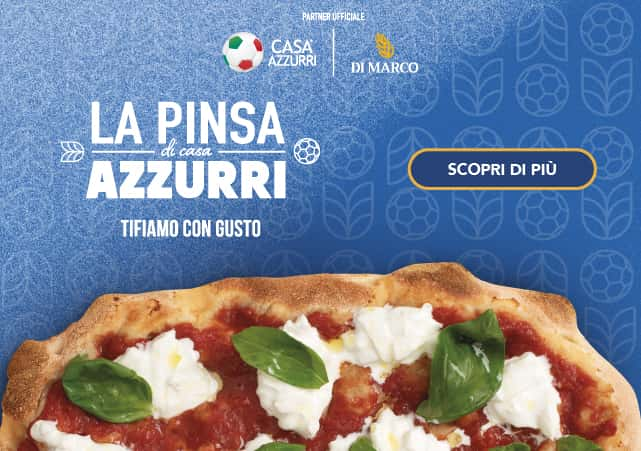Treccani encyclopaedia defines a pinseria as a "Catering establishment where pinsa and sometimes other foods are served"; but if we wanted to explain not only what a pinseria is but grasp its real essence, we could define it as an emerging concept on the culinary scene whose goal is to bring innovation to the traditional pizzeria market.
Differentiation as a driver of success
Let's start then with pizzerias. Opening one today represents a full-blown challenge, especially in terms of differentiation. According to data from the Italian Confederation of Craft Trades and Small- and Medium-Sized Enterprises, there are 127,000 venues selling pizza in Italy alone, so it is imperative to stand out to acquire a slice of a market worth 15 billion euros.
The need to make one's pizzeria stand out has fuelled the evolution of the last two decades: we have shifted from an image of the establishment as a rustic and cozy place for a quick meal to a modern and refined venue that serves gourmet pizza with the highest quality ingredients and novel flavour combinations. Meanwhile, again to stand out, some pizzerias have specialized in Italy's regional traditions, offering specific styles of pizza from different regions of the country: the low, crispy pan pizza form Rome and the pan (or tegamino) pizza from Turin are just a few f the dozens of variations that exist.
Over time, standing out has become increasingly difficult. Some pizzerias have begun serving many different dishes, others have focused on take-out relying on new delivery services, and still others have focused their offerings on special dietary needs, food choices, and lifestyles geared toward health and wellness.
What is a pinseria and how it was born
In 2001, we invented pinsa as a lighter and healthier alternative to pizza, but with characteristics that made it equally good and tasty. It is this improvement that has made it successful, and it has skyrocketed in the last 10 years due to an increasing interest in healthy, wellness-oriented eating.
At the same time, the first pinserie were born, at first only in central Italy (where pinsa was born), then throughout the peninsula, Europe and, finally, the world. Today the OPR (Original Pinsa Romana) Association registers certified pinserias in every part of the globe: in Moscow, Portugal, California, Australia, Venezuela and Canada, just to name a few. We can say that wherever there is pizza, pinsa has an opportunity to establish itself, because the need for healthy, tasty and light food is certainly not exclusive to our country.
Therefore, the definition by Treccani encyclopaedia about "what is a pinseria,", which briefly describes it as "the establishment where pinsa is served" is formally correct, but it is also true that innovation is deeper than simply producing and distributing new food. The pinseria is an venue that meets the new consumer needs and, therefore, has innovation in its DNA.
Pinseria as an opportunity for restaurateurs
The opportunity for restaurateurs is obvious. They can take advantage of the distinctive qualities of pinsa to create something new, perhaps in areas not yet covered by official pinserie, or breathe new life into an existing menu by adding a distinctive element to it. This opportunity also helps restaurateurs face the new competitive scenario created by delivery services: if yesterday the pizzeria competed only with establishments in its area, today it can have a wider market but also ten times the competition, and it can only emerge by standing out. The versatility of pinsa means that pinserie can present it in all its forms, answering to different needs: pinsa can accompany a quality aperitivo, it can be a dessert to end dinner, it can be the star of the meal or an alternative to focaccia. Restaurateurs can take advantage of its versatility to build a complete offer without having to divert to other foods; or they can introduce it into their own menu, but in this case it is best to focus not so much on its versatility as on the innovative element. Thus, recipes and pairings become decisive: since we are talking about differentiation, our advice is to dare. Without excess, certainly, but to dare.
Pinseria: the value of certification
The OPR Association was born out of the need to safeguard the authenticity of Pinsa Romana and carries out training and certification of pinserie, which after an examination of the quality of the product can bear the title of Original and Certified Pinseria.
But why is a certification important? As already mentioned, the success of pinsa depends on a mix of taste and lightness that is not easy to achieve. In fact, it is necessary to start with the right mix of flours, create a perfect dough, and properly manage hydration, leavening and baking. Even starting with the wrong mix or making a mistake in one of these steps is enough to create a product that is not in line with tradition and unsuitable to win over the consumer. Standing out with a poor-quality product is basically impossible.
In the face of an exponential increase in supply, it becomes necessary to safeguard the characteristics of the original product, preventing a product that does not conform to expectations from being served at the establishment. Only in this way is it possible to fulfil the promise of creating a tasty and light alternative to pizza, protecting both consumers and restaurateurs loyal to the tradition of Pinsa Romana.
For all these reasons, the Association, its training courses and certifications were born, involving both the venues (restaurants, pizzerie and pinserie) and the pinsaioli, a new professional figure destined for great success in the future.


